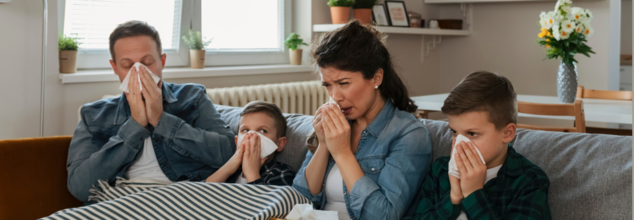- Health Conditions A-Z
- Health & Wellness
- Nutrition
- Fitness
- Health News
- Ayurveda
- Videos
- Medicine A-Z
- Parenting
Flu Is Contagious, This Is How Long It Can Last

Image Credit: Canva
Influenza, commonly known as the flu, is a highly contagious viral infection that primarily affects the upper respiratory system, including the nose, throat, and lungs. Unlike the stomach flu, which causes nausea, vomiting, and diarrhea, influenza leads to fever, chills, body aches, and respiratory symptoms such as coughing and congestion. While most people recover within a week, complications can arise, particularly in vulnerable groups.
The Centers for Disease Control and Prevention attributes this sudden increase to reduced exposure to the virus during the COVID-19 pandemic, leading to lower immunity among the population. Data from the CDC revealed that by the end of November, only 40% of adults in the United States had been vaccinated, thus exposing most of them to dangerous infections and complications. The flu season this year has been especially virulent for several reasons: people's immunity levels have not reached their peaks, circulation of viruses has been more frequent and the percentage of vaccination rates is relatively low.
How the Flu Spreads?
The flu is transmitted through tiny droplets expelled when an infected person coughs, sneezes, or talks. These droplets can land directly on another person's mouth or nose, leading to infection. Additionally, the virus can survive on surfaces like doorknobs, remote controls and keyboards for several hours. When a healthy individual touches these contaminated surfaces and then touches their face, they risk contracting the virus. Given its ease of transmission, the flu can spread rapidly in crowded environments such as schools, offices, and public transportation.
How Long Does the Flu Last?
Symptoms of flu persist for different times in different persons, depending upon their health and whether they had been vaccinated or not. However, the typical duration is within one to four days of contact and five to seven days later. Some will have a slightly milder reaction and illness when vaccinated. While others will get better sooner; others may remain ill for weeks. After disappearance of symptoms, there may also be fatigue which lasts for another few days.
Certain individuals are at a higher risk of developing severe flu-related complications, including pneumonia. These high-risk groups include:
- Infants and young children
- Adults aged 65 and older
- Pregnant individuals
- People with chronic medical conditions (e.g., asthma, diabetes, heart disease or HIV)
- Those with a body mass index (BMI) of 40 or higher
For these populations, the flu can escalate into life-threatening conditions making early intervention and prevention crucial.
How Long Is the Flu Contagious?
One of the most concerning aspects of influenza is its contagious period. According to the Centers for Disease Control and Prevention (CDC), individuals with the flu are most contagious during the first 3 days of their illness. However, the contagious period begins a day before symptoms appear and can extend up to seven days or more, depending on the severity of the illness.
An infected person can pass the flu a day before they even begin to feel symptoms.
The highest risk of transmitting the virus occurs between days two and four when symptoms are at their worst.
Even after symptoms have subsided, people may still be able to spread the flu for up to a week.
For instance, for those who have weakened immune systems or severe forms of the flu this contagious period can be significantly longer explaining why caution is needed when there is contact with other people.
Flu Prevention
Because flu is contagious, its prevention is one way of handling a reduction in infections. From simple to effective measures, the risk of infection can greatly be reduced:
1. Vaccination
The annual flu shot is the most effective way to protect against influenza. While it doesn’t guarantee complete immunity, it significantly reduces the risk of infection and severity of symptoms.
2. Stay Home When Sick
If you develop flu symptoms, staying home is the best way to prevent spreading the virus to others. Avoid close contact with household members, especially those at high risk for complications.
3. Practice Good Hygiene
- Wash hands frequently with soap and water for at least 20 seconds.
- Use hand sanitizer when soap is unavailable.
- Cover coughs and sneezes with a tissue or the inside of your elbow.
- Avoid touching your face, especially your mouth, nose and eyes.
4. Disinfect Surfaces
Regularly clean and disinfect frequently touched objects, including phones, countertops and doorknobs, to minimize the risk of contamination.
5. Wear Masks in Public Spaces
Wearing a mask, especially in crowded indoor environments can help reduce the spread of flu viruses, particularly during peak flu season.
When to See a Doctor
While most people recover from the flu without medical intervention, there are instances when professional care is necessary. Individuals at high risk for complications should consult a doctor at the first signs of illness. Antiviral medications like Tamiflu may be prescribed to shorten the duration and severity of symptoms.
Seek emergency medical care if you or a loved one experiences:
- Difficulty breathing or shortness of breath
- Chest pain or pressure
- Dizziness, confusion or difficulty waking up
- Bluish lips or face
- Severe muscle weakness
- Symptoms that worsen after initial improvement
- High fever (above 104°F)
These 5 Trends Could Shape Healthcare In 2026

Credits: iStock
As we step closer to 2026, let us look at what healthcare trends could shape the upcoming year. The 2026 healthcare trend will follow or shape on challenges that 2025 threw on us, these included a surge in lifestyle diseases, continuous cases of non communicable diseases, which are preventable, and a rise in infectious diseases. Based on them, the predictions of 2026 healthcare trends can be made.
Preventive Care Will Matter The Most
In 2026, healthcare will look most at prevention. As a significant portion of diseases, like the NCDs or the non communicable diseases, which also include half of all the cancers are preventable. This includes changes in lifestyle habits, including food habits, dietary fiber intake, exercise, and maintaining a regular sleep cycle.
Careful Use Of GLP-1 Medication
2025 saw a surge in the use of GLP-1 medication, however, this year also saw many reported unusual side effects of the medication. The year 2026 will emphasize more on the correct use of the medication, as well as, what areas must one pay heed to, especially after the medications have been stopped.
Also Read: These Are The 7 Common Mistakes People Make After Stopping Their Weight Loss Jabs
Shift In Patient Coverage
In the US, new changes have been done in Medicaid and its eligibility, which might change the rules on potential expiration of advanced premium tax credits. This may mean that many patients could become uninsured, or underinsured. Moreover, other changes in the coverage may include GLP-1 medication, as on November 6 of 2025, President Trump announced deals with Eli Lilly and Novo Nordisk slashed prices and brought coverage to eligible beneficiaries for just a $50 copay, down from $1,000 per month, out of the pocket.
DIY Skincare
Experts, like board-certified plastic surgeon John Diaz, MD, tells Cosmopolitan that 2026 will see a rise in DIY skincare trends. This would be making skincare products yourself, which could include yogurt face masks, to kitchen-sink sunscreen. However experts have pointed out that products which are not backed by science or have used ingredients without a correct measure could do more harm than good to the skin. “Many people who tried DIY skincare found these treatments to be inconsistent or ineffective. At the end of the day, consumers want efficacy, which drives them towards products formulated with scientifically proven ingredients," says the doctor.
Annual Testing To Become A Norm
In 2025, there were many cases of young people experiencing strokes and hear attacks. This has shifted the conversation on annual testing, regular screenings, and blood works for people who may fit the traditional definition of "healthy". Many people under the age of 40 have also reported cancer, which is what makes early screenings, annual testing, and blood work more important to ensure that everything in the body is working smoothly.
While getting checked once a year is not a new concept, however, it was mostly common in older adults, but now more young adults are also now considering getting annual tests done, as they are easily available and can help detect severe illness early.
You May Like To Read: Did Scientists Just Come Up With A New Blood Test That Detects And Monitors Lung Cancers In Real Time?
Adenovirus: Highly Contagious Mystery Illness Spreading Fast, Watch Out for These 12 Symptoms

Credits: Canva
The so-called “mystery virus” behind lingering sore throats, blocked noses filled with mucus, and days of exhaustion is actually well known to doctors. According to Eric Sachinwalla, medical director of infection prevention and control at Jefferson Health, the culprit is adenovirus.
What makes this virus particularly difficult to control is how tough it is. Adenovirus can survive soap and water, withstand many everyday disinfectants, and linger on contaminated surfaces for long stretches of time. Below is what experts know so far about this fast-spreading infection.
What Is Adenovirus?
Adenovirus refers to a group of common viruses that usually trigger cold- or flu-like illness. It spreads easily because it is far more resilient than many other viruses. Ordinary soap, water, and standard disinfectants do not reliably destroy it, allowing it to persist in the environment. As a result, infections often cluster in places where people spend time close together, such as daycares and military barracks. The virus spreads through the respiratory tract, can be shed in stool, and can survive for some time on contaminated surfaces, according to the CDC.
Adenovirus: What Are The Symptoms Of Adenovirus?
“Adenovirus is a typical virus that causes common cold or flu-like symptoms,” says Dr Deborah Lee at Dr Fox Online Pharmacy. That does not mean adenovirus is the same as a cold. Instead, adenovirus is one of many germs that can cause cold-like illness. A simple way to think about it is that a “cold” describes the symptoms, while adenovirus is one specific virus that can lead to them.
Symptoms can vary depending on the subtype involved. While there are more than 100 known subtypes, only 49 infect humans. Dr Lee notes that people may experience any of the following:
- Fever
- Runny nose
- Sore throat
- Swollen cervical lymph nodes in the neck
- Cough
- Shortness of breath
- Conjunctivitis
- Ear pain
- Diarrhoea
- Vomiting
- Stomach pain
- Urinary tract infection
Adenovirus? Is It Contagious?
“Adenovirus infection is highly contagious,” Dr Lee explains. “It spreads by breathing in infected droplets, by touching the virus and then rubbing the eyes, or through the faecal-oral route, often due to poor hand hygiene after using the toilet.”
She adds that the virus spreads quickly in crowded settings where people are in close contact. To eliminate adenovirus from surfaces, Dr Lee recommends stronger cleaning agents such as bleach-based solutions or hydrogen peroxide. “The virus is resistant to soap and many commonly used cleaners,” she says.
To reduce the risk of catching adenovirus or other respiratory infections currently circulating, Dr Lee advises staying away from people who are unwell. She also suggests the following precautions:
- Avoid touching your face and nose
- Use a clean tissue to blow your nose and dispose of it immediately
- Wash your hands often with soap and warm water, then dry them thoroughly, especially after using the toilet or changing nappies
- Clean children’s toys regularly
- Disinfect worktops, changing areas, toilets, and bathrooms
- Avoid sharing cups, plates, food, or towels
- Wear a mask if you need to go out while unwell
- Keep windows open and ensure rooms and workspaces are well ventilated.
Top 5 Health Crises That Impacted the World in 2025

Credits: iStock
As we soon step into 2026, it is time to look back at which diseases took over the world in 2025. These diseases evolved throughout the year, and led to complex challenges. Here, we explore the top 5 health crisis in 2025.
Infectious Diseases, Outbreaks, and COVID-19
This year, COVID-19 continued to make headlines, along with COVID, flu and measles too continued to infect people. In fact, new variants of COVID and flu have circulated across the world, leading to new kinds of symptoms, including razor-blade like throats in COVID-19. Influenza too surged up across US, UK, and Canada, with hospitalization rates going up. A new subclade K strain is seen responsible for this surge. Measles, too is a highly contagious, however, vaccine-preventable respiratory virus resurged this year, and this disease, which was once eliminated from the US, has come back due to lower rates of vaccination.
Tuberculosis Outbreak
A tuberculosis outbreak in the Kansas City metro area resulted in dozens of cases. This has led to two deaths, as reported by the Kansas Department of Health and Environment (KDHE). In fact, Michael A Bernstein, MD, director of pulmonary and critical care at Stamford Health said that many people assume that TB is rare and no longer a concern, however, it still remains common.
Also Read: Top 5 Infectious Diseases That Disrupted Healthcare System Worldwide In 2025
Bird Flu
In the US, the first death from bird flu was reported by the Louisiana Department of Health. The Centers for Disease Control and Prevention (CDC) reported that the individual was older than 65 years and had underlying medical conditions. That person developed severe illness and was hospitalized following the exposure to a noncommercial backyard flock and wild word. In fact, new studies have shown that bird flu viruses could have a potential risk for humans and may become next pandemic. This comes from two different studies, one done by the universities of Cambridge and Glasgow that show how avian flu strains are multiplying even when the body temperatures could hinder viruses. Whereas, another important study led by Indian scientists, by Philip Cherian and Gautam Menon of Ashoka University, published in BMC Public Health predict if H5N1 or the bird flu virus, could start spreading among humans.
Antimicrobial Resistance (AMR)
In 2025, AMR has worsened and the resistance has risen over 40% of monitored pathogen-antibiotic pairs between 2018-2023. Due to the resistance, common infections become harder to treat, especially in regions like Southeast Asia, with India facing high rates. The World Health Organization (WHO) report notes that AMR is a growing threat to global health, and draws on more than 23 million bacteriologically confirmed cases of bloodstream infections, urinary tract infections, gastrointestinal infections, and urogenital gonorrhoea.
Non Communicable Diseases or NCDs
NCDs like heart disease, cancer, diabetes, and respiratory illnesses remained a persistent global health challenge in 2025. Trends to showed a continued rise driven by unhealthy lifestyles, which included processed food, inactivity, tobacco or alcohol, and urbanization.
© 2024 Bennett, Coleman & Company Limited

